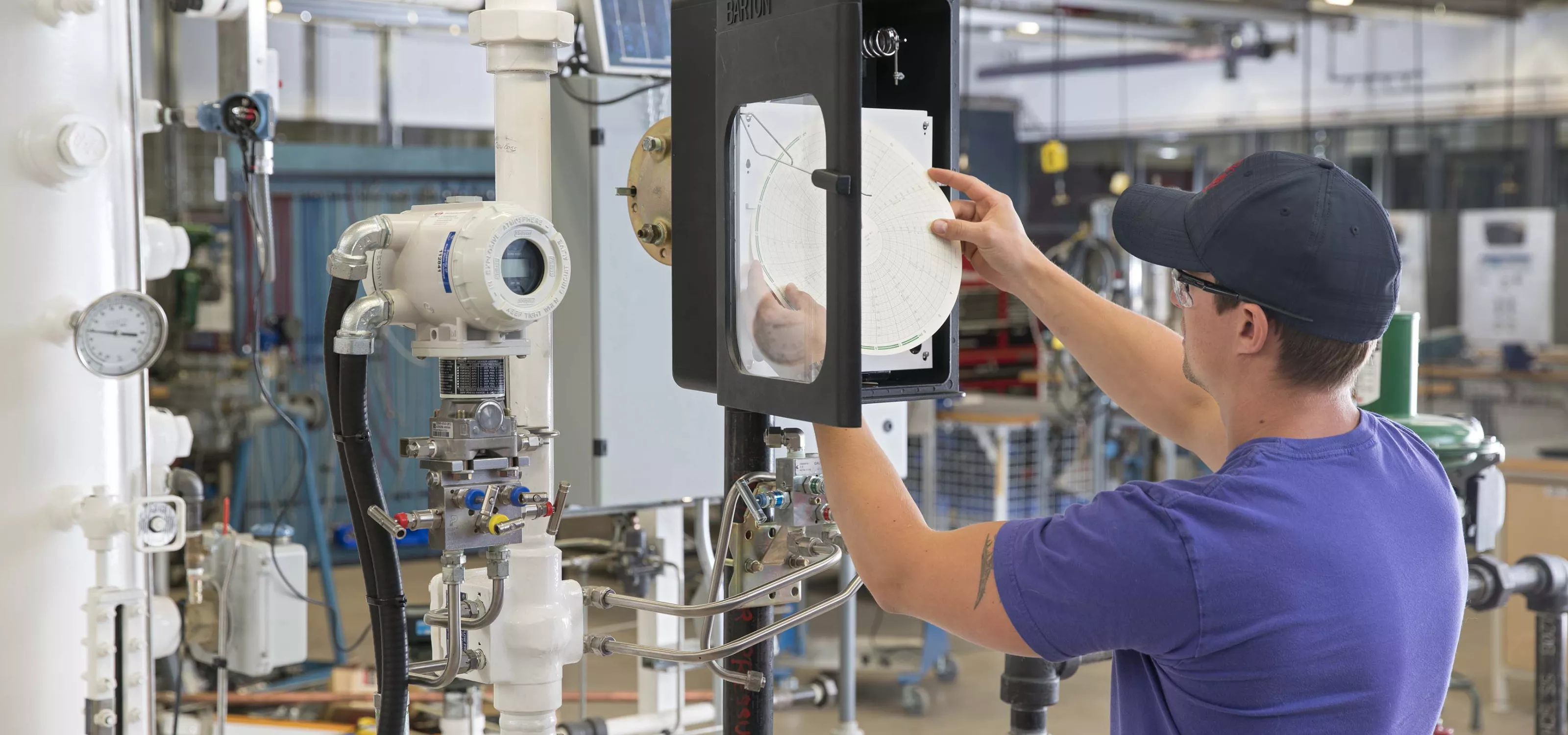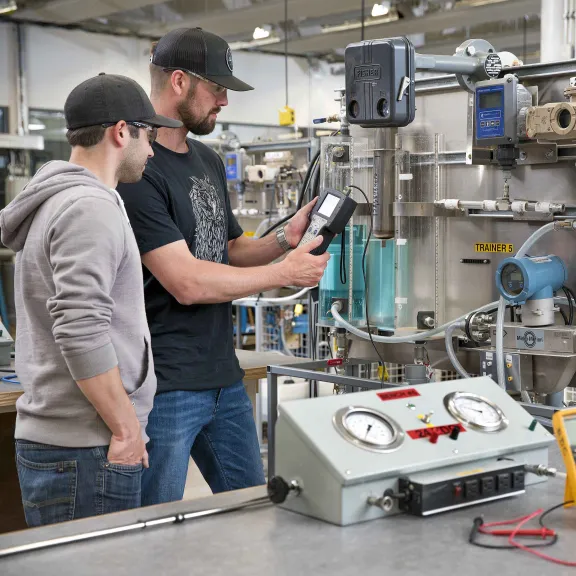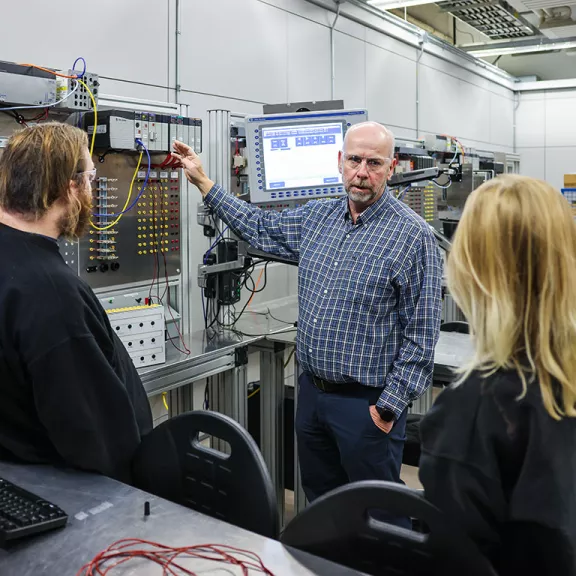
Instrumentation and Control Technician Apprenticeship
About the Instrumentation and Control Technician Apprenticeship
Combine your love of technology with your interest in math, science and mechanics to become an Instrumentation and Control Technician. This ever-evolving field is needed virtually anywhere there are control and metering systems as the world becomes increasingly automated.
In this program, you will learn to install, maintain and repair the measuring and control devices used in industrial and commercial processing. You will spend a lot of your technical training in shops to support and apply the theory you learn in class.
You will work with a wide variety of pneumatic, electronic and microcomputer instruments used to measure and control variables such as pressure, flow, temperature, level, motion, force, and chemical composition.
Instrumentation and Control Technicians find employment in pulp and paper processing, mining, petrochemical and industrial instrument servicing, as well as the oil and gas industry.
Experienced Instrumentation and Control Technicians may advance to supervisory positions or move into company sales offices.
When you graduate, you’ll receive both a:
Journeyperson Certificate: This certificate not only acknowledges your expertise in your chosen trade but also grants you the legal authority to work in that trade.
Education Credential: This is a formal testament to your dedication and hard work. It confirms that you've successfully finished an Advanced Diploma in a post-secondary study program and highlights the time and effort you've invested in mastering your trade or profession.
Work-integrated Learning
Apprenticeship is a unique form of post-secondary education that blends hands-on work experience with classroom learning. On average, you will spend 80 per cent of your apprenticeship on the job, practicing your trade or profession, and 20 per cent in the classroom or lab through structured learning at RDP.
Further Study
At the end of the final year of the program, you will also be eligible to earn a Red Seal Endorsement on your Journeyperson certificate upon successful completion of the Red Seal Exam. The Red Seal Endorsement allows Journeypersons to work anywhere in Canada without additional training.
If you have a valid Alberta Journeyperson Certificate, you are eligible to receive a Blue Seal Achievement in business competencies after completing the necessary requirements.
Program Content
During year one and two of this program you will spend eight weeks on campus every year, and a minimum of 1,500 hours on-the-job training. During year three and four you will spend 10 weeks on campus and a minimum of 1,425 hours on-the-job training.
Completion of Classroom Training
Students must achieve a weighted average of 65% with no section under 50% in both the theory and practical components of the classroom training as well as achieving a minimum grade of 70% on the AIT Provincial Exam for each period of classroom training.
Completion of a Journeyperson Certificate
The term of apprenticeship for instrumentation and control technicians is four years (four 12-month periods), including a minimum of 1,560 hours of on-the-job training and eight weeks of classroom instruction in the first and second years, and a minimum of 1,500 hours of on-the-job training and 10 weeks of classroom instruction in the third and fourth years.

Related Careers
Instrumentation and Controls Technician
Sales
Programming
Maintenance
Construction

Meet the Faculty
At Red Deer Polytechnic we are proud of our faculty members and staff who are experts in their disciplines and subject areas.
Admission Requirements
How to become an Apprentice:
Ensure you meet Apprenticeship and Industry Training (AIT) eligibility and entrance requirements for your desired skilled trade.
Apply for an Apprenticeship Education Program.
Register for classroom instruction.
Academic Requirements
Apprenticeship and Industry Training (AIT) entrance requirements:
ELA 20-2
Math 30-3
Physics 30
Chemistry 30
OR
Successful completion of AIT’s entrance exam
Intake Details
Registration opens May 14, 2025
*Please note: registration can be completed online through the MyTradeSecrets (MTS) system. Assistance is available directly from your local Apprenticeship and Industry Training (AIT) office (hours may vary). Or from the RDP Office of the Registrar at 403-342-3100 or via email between 8:30am-4:30pm, Monday through Friday.
1st Period
September 15, 2025 - December 5, 2025
- Blended delivery
- On Campus requirements
- October 27-31, 2025 | 8:30am-3:30pm
- November 3-7, 2025 | 8:30am-3:30pm
January 5, 2026 - February 27, 2026
- On campus delivery
- On campus time requirements
- Monday-Friday | 8:30am-3:30pm
April 7, 2026 - June 26, 2026
- Blended delivery
- On Campus requirements
- May 19-22, 2026 | 8:30am-3:30pm
- May 25-29, 2026 | 8:30am-3:30pm
2nd Period
September 15, 2025 - December 5, 2025
- Blended delivery
- On Campus requirements
- October 20-24, 2025 | 8:30am-3:30pm
- November 10 & 12-14, 2025 | 8:30am-3:30pm
January 5, 2026 - February 27, 2026
- On campus delivery
- On campus time requirements
- Monday-Friday | 8:30am-3:30pm
April 7, 2026 - June 26, 2026
- Blended delivery
- On Campus requirements
- May 11-15, 2026 | 8:30am-3:30pm
- June 1-5, 2026 | 8:30am-3:30pm
3rd Period
September 2, 2025 - December 5, 2025
- Blended delivery
- On Campus requirements
- October 27-31, 2025 | 8:30am-3:30pm
- November 3-7, 2025 | 8:30am-3:30pm
January 5, 2026 - March 13, 2026
- On campus delivery
- On campus time requirements
- Monday-Friday | 8:30am-3:30pm
4th Period
March 23, 2026 - June 26, 2026
- Blended delivery
- On Campus requirements
- May 19-22, 2026 | 8:30am-3:30pm
- May 25-29, 2026 | 8:30am-3:30pm
Program Cost
These costs are an estimate of tuition and fees based on the recommended course load per training period.
NOTE: Additional fees may apply.
For full fee information, view our Program Cost Estimates.
Financial Aid Options
Student life can be very expensive, and few individuals have enough money to pay up-front for their post-secondary education.